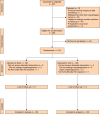Multicentre randomized clinical trial on robot-assisted versus video-assisted thoracoscopic oesophagectomy (REVATE trial)
- PMID: 38960881
- PMCID: PMC11221944
- DOI: 10.1093/bjs/znae143
Multicentre randomized clinical trial on robot-assisted versus video-assisted thoracoscopic oesophagectomy (REVATE trial)
Abstract
Background: Surgery for oesophageal squamous cell carcinoma involves dissecting lymph nodes along the recurrent laryngeal nerve. This is technically challenging and injury to the recurrent laryngeal nerve may lead to vocal cord palsy, which increases the risk of pulmonary complications. The aim of this study was to compare the efficacy and safety of robot-assisted oesophagectomy (RAO) versus video-assisted thoracoscopic oesophagectomy (VAO) for dissection of lymph nodes along the left RLN.
Methods: Patients with oesophageal squamous cell carcinoma who were scheduled for minimally invasive McKeown oesophagectomy were allocated randomly to RAO or VAO, stratified by centre. The primary endpoint was the success rate of left recurrent laryngeal nerve lymph node dissection. Success was defined as the removal of at least one lymph node without causing nerve damage lasting longer than 6 months. Secondary endpoints were perioperative and oncological outcomes.
Results: From June 2018 to March 2022, 212 patients from 3 centres in Asia were randomized, and 203 were included in the analysis (RAO group 103; VAO group 100). Successful left recurrent laryngeal nerve lymph node dissection was achieved in 88.3% of the RAO group and 69% of the VAO group (P < 0.001). The rate of removal of at least one lymph node according to pathology was 94.2% for the RAO and 86% for the VAO group (P = 0.051). At 1 week after surgery, the RAO group had a lower incidence of left recurrent laryngeal nerve palsy than the VAO group (20.4 versus 34%; P = 0.029); permanent recurrent laryngeal nerve palsy rates at 6 months were 5.8 and 20% respectively (P = 0.003). More mediastinal lymph nodes were dissected in the RAO group (median 16 (i.q.r. 12-22) versus 14 (10-20); P = 0.035). Postoperative complication rates were comparable between the two groups and there were no in-hospital deaths.
Conclusion: In patients with oesophageal squamous cell carcinoma, RAO leads to more successful left recurrent laryngeal nerve lymph node dissection than VAO, including a lower rate of short- and long-term recurrent laryngeal nerve injury. Registration number: NCT03713749 (http://www.clinicaltrials.gov).
Plain language summary
Oesophageal cancer often requires complex surgery. Recently, minimally invasive techniques like robot- and video-assisted surgery have emerged to improve outcomes. This study compared robot- and video-assisted surgery for oesophageal cancer, focusing on removing lymph nodes near a critical nerve. Patients with a specific oesophageal cancer type were assigned randomly to robot- or video-assisted surgery at three Asian hospitals. Robot-assisted surgery had a higher success rate in removing lymph nodes near the important nerve without permanent damage. It also had shorter operating times, more lymph nodes removed, and faster drain removal after surgery. In summary, for oesophageal cancer surgery, the robotic approach may provide better lymph node removal and less nerve injury than video-assisted techniques.
© The Author(s) 2024. Published by Oxford University Press on behalf of BJS Foundation Ltd.
Figures


References
-
- Udagawa H, Ueno M, Shinohara H, Haruta S, Kaida S, Nakagawa M et al. The importance of grouping of lymph node stations and rationale of three-field lymphoadenectomy for thoracic esophageal cancer. J Surg Oncol 2012;106:742–747 - PubMed
-
- Fujita H, Sueyoshi S, Tanaka T, Fujii T, Toh U, Mine T et al. Optimal lymphadenectomy for squamous cell carcinoma in the thoracic esophagus: comparing the short-and long-term outcome among the four types of lymphadenectomy. World J Surg 2003;27:571–579 - PubMed
-
- Tachibana M, Kinugasa S, Yoshimura H, Shibakita M, Tonomoto Y, Dhar DK et al. Clinical outcomes of extended esophagectomy with three-field lymph node dissection for esophageal squamous cell carcinoma. Am J Surg 2005;189:98–109 - PubMed
Publication types
MeSH terms
Associated data
Grants and funding
LinkOut - more resources
Full Text Sources
Medical

